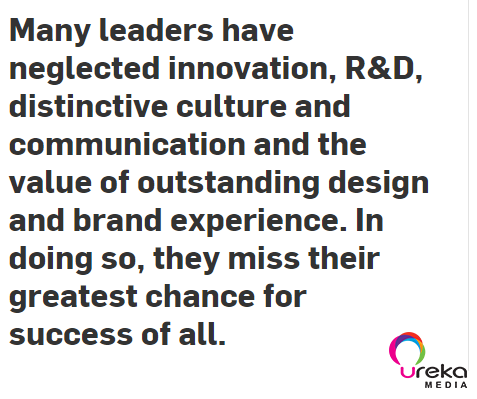


Make people SEE and REMEMBER the brand



Get people to UNDERSTAND and
WANT the brand



Change people's BEHAVIOR and
get them to CONVERT



Take care of people to CONVERT OFTEN and
ADVOCATE the brand
U News
Prioritizing Creativity and Societal Value Will Lead to Organic Brand Growth
Cutting costs and avoiding risks has held them back from innovation

The best interests of businesses and societies haven’t always been on different trajectories. From the Industrial Revolution to the birth of modern economies, these two were often unified. Innovation in business went hand-in-hand with improvement to quality of life, and the ambitions of business and society were fundamentally intertwined. Railways, for example, lowered shipping rates, opened up new markets, increased access to affordable supplies, created jobs and formed the basis on which previously isolated areas could thrive. Railway owners prospered. Society prospered. And so it was across many industries. It seems like a simple equation: The companies that made money and prospered in the world were those who benefitted people the most.
By the 1960s and ‘70s, this had changed. The rise of complex financial instruments meant that organizational success was no longer solely reliant upon the mechanics of industry but could be built on the mechanics of share prices and money markets instead. The value a business added to society found itself becoming increasingly relegated below consideration of the value added to shareholders to the point that some questioned whether value to society was in any way relevant to business at all. At the point when the financial crisis began in 2007, this trend had reached its peak, and destructive practices had done their damage.
But those days are now over. The rise of digital platforms, demand for transparency, the prolonged impact of the worldwide financial crisis and heightened overall scrutiny has created a new paradigm for new and legacy corporations. Brands are again being judged by their value to society. This is due, in part, to consumers seeking to engage with socially responsible brands, but also because those same consumers are now becoming the CEOs, shareholders, analysts and sources of funding for businesses and are aligning their interests to a more connected and fair extent than their predecessors achieved.
The message is clear: The businesses of the future must be highly connected, socially responsible entities that align their best interests with those of multiple audiences in new and inspiring ways.
For too long, the management discipline has been concerned with risk aversion, cost elimination and other destructive techniques that are effective measures toward incrementally improved profitability. These techniques have been too highly prioritized by most organizations and have, in fact, stifled the bigger source of opportunity for top and bottom line growth: creativity. Taught by their business schools and peers to be paralyzed by fear of risk or by the prospect of not immediately measurable ROI, many leaders have neglected innovation, R&D, distinctive culture and communication and the value of outstanding design and brand experience. In doing so, they miss their greatest chance for success of all.

Imagine in 1997, when Steve Jobs returned to Apple as CEO, that his solution to the company’s then-troubles had focused on a wholesale program of cost efficiencies and supply-chain rationalization. Imagine that Amazon had stuck to selling books or that Google just did search. Organizations that want to emulate the success of these companies need to follow their lead and make societal value and creativity the drivers of their business, promote it over destructive management techniques and invest time and money in its pursuit.
As the best interest of business and society reunite, it is organizations that follow principles such as these that will succeed to the benefit of all.
Source: Adweek
Recent Post



![[PERFORMANCE BASED ADS] NHỮNG CÁCH ĐƠN GIẢN ÁP DỤNG TÂM LÝ HỌC VÀO TRUYỀN THÔNG TIẾP THỊ MẠNG XÃ HỘI (SOCIAL MARKETING)](https://urekamedia.com/uploads/uploads_image/20180327/20180327110011_48608.png)






